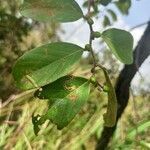A gnarled shrub or small tree. It grows 6-15 m high. The trunk is crooked and it branches low down. The bark is dark grey and rough and often scaly. The small branches are long and thin. They can have short spines. The leaves are usually 3.5-10 cm long by 2.5-6 cm wide. The leaves have a tip which curves downwards. The leaf stalks are 5 mm long, stout and hairy. The flowers are creamy yellow and have a scent. The fruit are oval and 6-7.5 mm long. The fruit persist on the branches.
Male flowers: pedicels 1–1.5 mm long, puberulous; sepals 2 × 1 mm, triangular-ovate-lanceolate, acute, puberulous without, glabrous within, yellowish-green; petals 1 × 0.75 mm, obdeltoid-spathulate, incised or tridentate at the apex, cornute, glabrous; disk 1.5–2 mm in diameter, annular, ± smooth; staminal column 1 mm high; anthers 0.7 × 0.5 mm; pistillode 0.5 mm high, conical, notched at apex.
Female flowers subsessile; sepals 1.5 × 1.5 mm, triangular, thick, otherwise as in male; petals elliptic-obovate, puberulous without, otherwise as in male; outer disk ± as in male; inner laciniate at the apex, ciliate within, pubescent or subglabrous; ovary 1.5 × 1 mm, ellipsoid, 2-celled; styles 2, c. 1 mm long, ± free, bifid, stigmas ± smooth.
Fruit c. 7 × 4–5 mm when dried, ellipsoid to ovoid-ellipsoid, 1-locular by abortion, green at first, then reddening and becoming purplish-black at maturity.
Stipules 5–6 × 1.5–2 mm, lanceolate, acuminate, tomentose, readily caducous.
A shrub or small tree up to c. 6 m high with spiny branches.
A savannah shrub or tree, to 20 ft. high, often with spines
Young shoots and petioles denseley ferrugineous-tomentose.
Seeds 5 × 3 mm, smooth, brownish.
Flowers greenish-yellow
Petioles 5–7 mm long.
Bark cracked, grey.
Twigs dark brown.
Reddish disk



